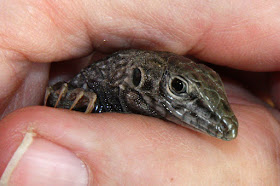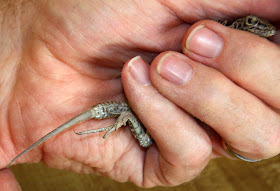Melinda and I are just returned from the 2013
Riverside Telescope Makers Conference. Always held over Memorial Day, I've been attending since 1986 except for 1988 when my Mom died and a couple years back when they disastrously tried to make it an observers event and moved it away from Memorial Day Weekend... Living in some pretty pristine skies, I've always gone for the camaraderie and telescope making - seeing what people are doing and catching up with old friends... In recent years attendance has nosedived and it is always a big question mark as to who will show up for the event, and like last year, Camp Oakes seemed pretty deserted for a Friday midafternoon.
So we ambled around... It wasn't 6 years ago and you couldn't walk across the "Telescope Field" with all the vendor tents, which had displaced all the home-built telescopes. This year there were a total of 3 vendors at the edge of the deserted field. Fortunately, as we continued down "Telescope Alley" we ran into the camp of Gerry Logan and Bob Pfaff, telescope makers extraordinaire! RTMC attendance could drop to 50, and as long as Gerry was there to talk to, I'd be coming back! He had repackaged a 7"
Schupmann telescope, folding it and building a new chain drive mounting for it, shown at left.

A couple meters down the road and we ran into Jack Eastman who had found a volunteer offering an AP900 mounting onto which to mount his 130 year old 6" Alvin Clark refracting telescope. The Clarks were the preeminent telescope makers of the 1800s and even today are held in high regard for both their small jewels of telescopes as shown here, and also for the largest refractors ever made, including the
24" at Lowell Observatory and the
40" at Yerkes Observatory. At left Jack is using a sweatshirt to take up the gap in the oversize clamping rings on the mount. At right they are doing the fine balance of the equatorial mount. We made plans to come back a little later to observe through it - Jack himself admitted to never having it on a tracking mount other than the hand-turned tracking drive on the original mount. It would be a lot easier for some critical observations with the tracking mount...

With the full moon Friday night (in fact, there was a very partial
lunar eclipse that night!), there wasn't much serious observing going on - most everyone was looking at Saturn that was moderately high in the Southeastern sky. Interestingly, there were 3 scopes about the same size to compare - Tele Vue had a 5" Petzval (4 elements in 2 groups) that works at F/5.2, VERY fast for a refractor, but at about 180X, was showing pretty good views of Saturn. Shown at left with the deserted telescope field, turns out I was observing with Jose Magsaysay, who I met years ago at the Grand Canyon Star Party... A few minutes later, over at Jack Eastman's Clark 6", I waited behind TAAA member Gary Rosenbaum for a detailed look at Saturn, running about 250X. By the way, these night time shots are taken with my Canon XSi with Nikon 16mm fisheye at F/4, exposures about 6 to 13 seconds - easy to aim by moonlight and short enough to get pretty good detail.


I also went by Gerry Logan's camp and took a look through his Schupmann. He was running it at pretty low power, and at F/10 isn't really designed for high-powered planetary views. We examined the bright star Regulus and marveled at the relay mirror adjustment that nulls out the color error in the design. He had done a fine job with the scope and adjustments. Gerry is shown here at left in the black jacket while an observer checks out the view. Finally Melinda caught up to me (she was warming up in the car with temps in the 30s), and we looked through the Explore Scientific 5" APO that is F/7.5. Unfortunately it wasn't on a tracking mount and at low power the image couldn't be critically examined. Company president Scott Roberts here in the green jacket was there to answer questions for those gathered.
Oh, and the winner of the 5" or 6" Saturn Observing Challenge? The 130 year-old Clark won hands down, the longer focal length and doublet way outperforming the much faster 3 and 4-element systems!

We didn't stay late with the full Moon and cold
temps, so headed back to Big Bear for our room at Motel 6, an easy 15 minute drive. The traditional swap meet usually starts at dawn Saturday, and the speaker program starts at 9, but we got a late start and swept through the swap meet on the way to Jack Eastman's talk on the cleaning and restoration work on the 20" Saegmuller refractor of Chamberlin Observatory in Denver (another Clark telescope!). Shown in the picture at left is the lens-down cell of the telescope with the director of Chamberlin shown. Another speaker later in the day was former publisher, editor, author, and software engineer Richard Berry covering much of the details of lens design from simple lenses to advanced astro-graphic systems in the 60 minute talk. He is shown at right... It was an interesting talk once he got past the misbehaving microphone system!

Between these two talks that started and ended
the speaker program for the day, we perused the swap meet and caught up with friends and acquaintances met over the years. At left Teresa Plymate (TAAA member and current Big Bear residents!) tried to twist some arms in selling her and Claude's 14" telescope. And at right Gene Lucas and Mike Spooner discuss some details of telescope optics over lunch. We did our part in spending money at the swap meet and vendors - of course, we had to get the current-epoch RTMC t-shirts, and I was looking for a 4" diagonal for my 14" Newtonian telescope project, which I found there - interestingly, supposedly tested by buddy Bob Goff who died a decade ago! I also bought a flash for my Canon, but owned it for only about 2 minutes before a fellow who had run off to get cash to pay for it returned. I gave it up and made a dollar in the process... I was tempted by many other offerings - fortunately the attendance about doubled between Friday and Saturday.
But as I said before, as long as the meeting continues to exist and my die-hard friends continue to attend, it offers a great venue to catch up, talk shop and spend some time under the stars with some truly unique optics. I always swear I'll bring an entry next year - time to pull the trigger and show something. It won't likely grow again until we all take a step to help out. Come join us next Memorial Day!
 I just can't seem to get enough of the latest Comet PanSTARRS performance. The Earth crossed the orbital plane of the comet early in the week, and instead of a anemic comet with a small tail, the comet appears to have a HUGE anti-tail many degrees long! It isn't very bright, but still visible in hand-held binoculars, including a couple degrees of anti-tail. But it is still easy to photograph, with exposures of a fraction of a minute showing it and its new tail appendage.
I just can't seem to get enough of the latest Comet PanSTARRS performance. The Earth crossed the orbital plane of the comet early in the week, and instead of a anemic comet with a small tail, the comet appears to have a HUGE anti-tail many degrees long! It isn't very bright, but still visible in hand-held binoculars, including a couple degrees of anti-tail. But it is still easy to photograph, with exposures of a fraction of a minute showing it and its new tail appendage.















































